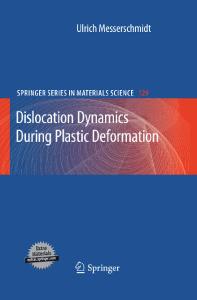Dislocation Dynamics During the Deformation of Intermetallic Alloys and the Flow Stress Anomaly
- PDF / 1,739,380 Bytes
- 6 Pages / 408.96 x 639 pts Page_size
- 50 Downloads / 420 Views
3 the strain rate e, the specimens were deformed at high rates, if possible up to 10- s-1, and the relaxation curves were recorded over a wide range of t (and a). Values of r for different t were obtained by determining the slope of the relaxation curves at different 6. Corresponding e values were calculated by t= -a/S, with S being the stiffness modulus of specimen and grips.
Figure 1. Configurations of ordinary dislocations of Burgers vectors b and slip planes s taken during in situ straining experiments in an HVEM. a) NiAI at RT, b = (100), s = {001}; b) NiAI-Ta at RT, b = (100), s = {001}; c) TiAI at RT, b = 1/2(110], 0 s = {111}; d) MoSi 2 after in situ deformation at 450 C, b = 1/2(111), s = {110). Slip traces run always horizontal
DISLOCATION DYNAMICS Fig. 1 shows the shape of dislocations under load and lists the types of the dominating simple Burgers vectors in NiAl, NiAl-Ta and TiAl at room temperature (RT), and in MoSi 2 taken after an in situ experiment at 450 'C, which is a relatively low temperature for MoSi 2. In the first three cases, mostly screw dislocations bow out between obstacles. The obstacles have been identified as jogs in NiAl [6] and NiAl-Ta [7], and they may be small precipitates in TiAl [4]. Between the stable configurations, the dislocations move jerkily. In MoSi 2, the dislocations are relatively straight of 300 and 600 character. At high temperatures, i.e. at temperatures of the flow stress anomaly in TiAl and MoSi 2, the dislocations change their mode of motion drastically. In Fig. 2, the dislocations no longer bow out between obstacles but are smoothly curved in NiAl and TiAl. In MoSi2, they consist now of very straight segments of 600 and edge character. In all materials studied, the motion is viscous, which obviously is a general feature of intermetallic alloys at high temperatures. In the two materials with a flow stress anomaly, TiA1 and MoSi 2, the dislocations multiply and move very fast like an avalanche during the first loading in the in situ experiments, as was observed before [2]. Thus, the dislocations can obviously move at a given stress either at low or high velocities. POINT DEFECT ATMOSPHERES AROUND DISLOCATIONS AND THE FLOW STRESS ANOMALY The dislocation dynamics in several intermetallic alloys has shown that the thermally activated mechanisms controlling the dislocation mobility at low temperatures no longer act at high ones. Hence, the dislocation motion should be governed solely by the long-range internal stresses, resulting in a very jerky motion. In contrast to that, the dislocations move viscously. Thus, at high temperatures, an additional mechanism should be active causing the viscous motion and giving rise to a flow stress anomaly in the respective materials. In [10], it is proposed that this mechanism may be the formation of point defect atmospheres in the cores of the moving dislocations. If point defect atmospheres form around dislocations, they may be partly dragged behind causing a friction stress of, which depends on KK10.9.2
Figure 2. Configurati
Data Loading...











